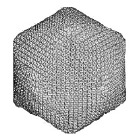Plant Pathology, Department of

James Van Etten Publications
Document Type
Article
Date of this Version
2-2013
Citation
J. Gen. Physiol. Vol. 141 No. 3 389–395 www.jgp.org/cgi/doi/10.1085/jgp.201210940
Abstract
The modular architecture of voltage-gated K+ (Kv) channels suggests that they resulted from the fusion of a voltage-sensing domain (VSD) to a pore module. Here, we show that the VSD of Ciona intestinalis phosphatase (Ci-VSP) fused to the viral channel Kcv creates KvSynth1, a functional voltage-gated, outwardly rectifying K+ channel. KvSynth1 displays the summed features of its individual components: pore properties of Kcv (selectivity and filter gating) and voltage dependence of Ci-VSP (V1/2 = +56 mV; z of approx. 1), including the depolarizationinduced mode shift. The degree of outward rectification of the channel is critically dependent on the length of the linker more than on its amino acid composition. This highlights a mechanistic role of the linker in transmitting the movement of the sensor to the pore and shows that electromechanical coupling can occur without coevolution of the two domains.


Comments
© 2013 Arrigoni et al. Used by permission.